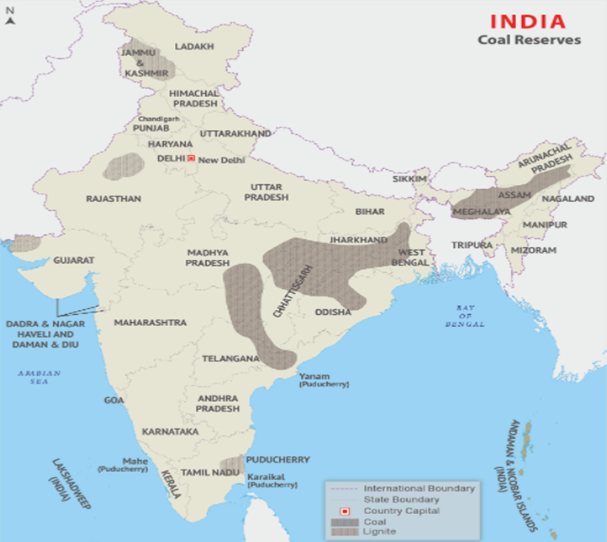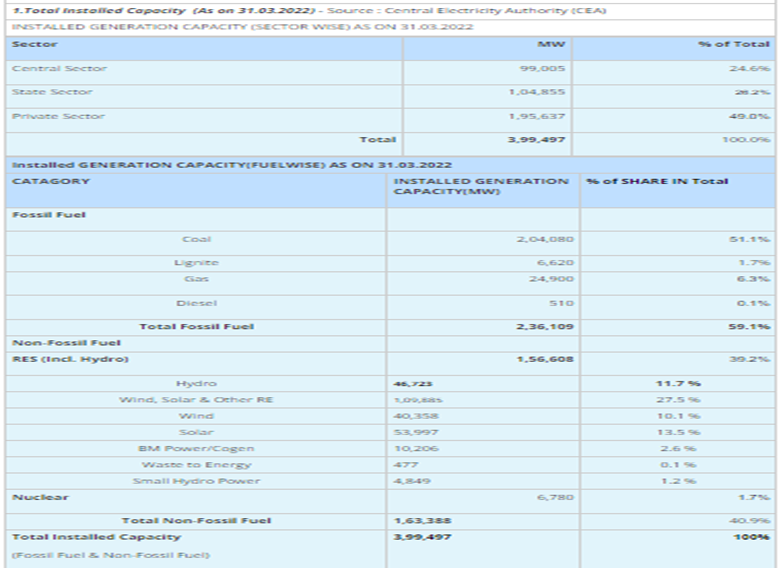In News:
- An energy crisis is emerging across India, as low coal supplies across the majority of thermal power plants have triggered blackouts in several urban and rural areas.
- The situation has become worse by the fact that domestic demand for power has increased manifold as a result of an abnormally early and record-breaking heatwave and dry weather.
What’s in today’s article:
- Distribution of coal reserves across India (Classification of coal, coal reserves in India)
- The statistics related to power in India
- The phenomenon of heatwave
- News Summary
Distribution of Coal reserves across India:
- Classification of Coal (on the basis of carbon content and time period):
- On the basis of carbon content:
- Anthracite (80 - 95% carbon content, found in small quantities in J&K).
- Bituminous (60 - 80% of carbon content and is found in Jharkhand, West Bengal, Odisha, Chhattisgarh and Madhya Pradesh).
- Lignite (40-55% carbon content, high moisture content and is found in Rajasthan, Lakhimpur (Assam) and Tamil Nadu).
- Peat (less than 40% carbon content and it is in the first stage of transformation from organic matter (wood) to coal).
- On the basis of a time period:
- Gondwana coal (around 98% of India's total coal reserves). This coal was formed about 250 million years ago.
- Tertiary coal- is of younger age. It was formed from 15 to 60 million years ago.
- Coal reserves in India (State-wise):

- Jharkhand:
- With estimated 83.15 billion tonnes of reserves which is more than 26% of India’s total reserves, Jharkhand ranks first.
- The state’s main coal-mining centres are Jharia (India’s oldest and richest coalfield), Bokaro, Auranga, Giridh, Dhanbad, Ramgarh, Karanpur and Hutar.
- Odisha: Second on the list for coal reserves is the state of Odisha (over 24% of the country’s total reserves and about 15% of India’s total coal production). Talchar is Odisha's biggest coalfield.
- Chattisgarh: Chhattisgarh has the third largest coal reserve in India and carries about 17% of the total coal reserves. However, the state has the first rank in the production of coal. Coalfields of the state include Korba, Hasdo-Arand, Chirmiri, Jhimli, and Johilla.
- Others are West Bengal (about 11% of the total coal reserves of India), Madhya Pradesh (about 8%), Andhra Pradesh (7%), Maharashtra, Rajasthan, Gujarat, Tamil Nadu, Jammu and Kashmir.
The statistics related to power in India:

Heat wave:
- About the phenomenon:
- Qualitatively, a heat wave is a condition of air temperature which becomes fatal to the human body when exposed.
- Quantitatively, it is defined based on the temperature thresholds over a region in terms of actual temperature or its departure from normal.
- Criteria for declaring heat waves:
- Heat wave is considered if the maximum temperature of a station reaches at least 40 degrees Celsius or more for Plains and at least 30 degree Celsius or more for Hilly regions.
- Based on Departure from Normal:
- Heat Wave: Departure from normal is 4.5 - 6.4 degree Celsius.
- Severe Heat Wave: Departure from normal is > 6.4 degree Celsius.
- Based on Actual Maximum Temperature:
- Heat Wave: When actual maximum temperature ≥ 45 degree Celsius.
- Severe Heat Wave: When actual maximum temperature ≥ 47 degree Celsius.
- Criteria for coastal stations: When maximum temperature departure is 4.5 degree Celsius or more from normal, Heat Wave may be described provided actual maximum temperature is 37 degree Celsius or more.
- How does the India Meteorological Department (IMD) monitor the Heat wave?
- IMD has a big network of surface observatories to measure various meteorological parameters like Temperature, Relative humidity, pressure, wind speed and direction
- Based on daily maximum temperature station data, IMD declares a heat wave over the region as per its definition.
News Summary
- According to the Ministry of Power, the peak power demand in the country touched an all-time high of 207,111 MW recently, amid a severe heatwave spell across India, the hottest since 1901 (when records first started being kept).
- However, electricity production has declined as coal supplies have become critically low in many states that rely largely on coal-fired plants for power generation, including Haryana, Bihar, Jharkhand, Rajasthan, Madhya Pradesh, Gujarat, etc.
- The dry weather exacerbated the problems by depleting river water levels, reducing hydropower production.
- As the shortages fuelled fears of major blackouts, many governments implemented methods such as selective power cuts in rural areas to meet demand in urban and industrial areas.









